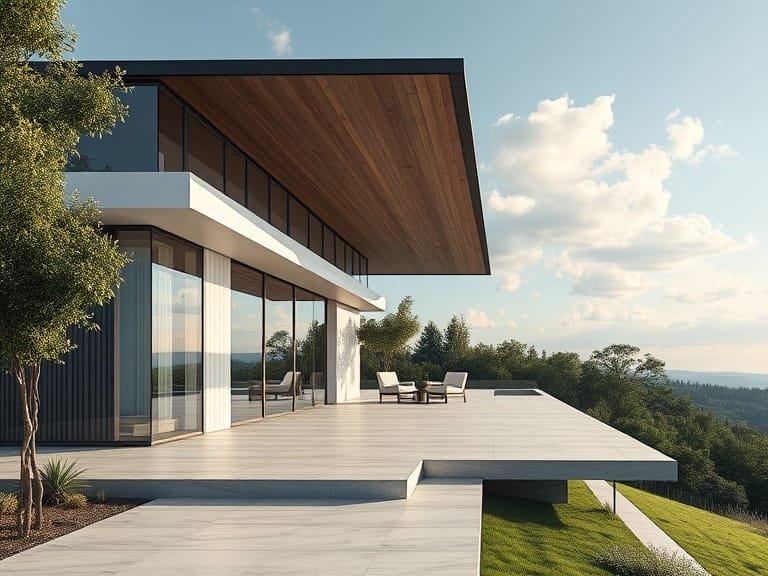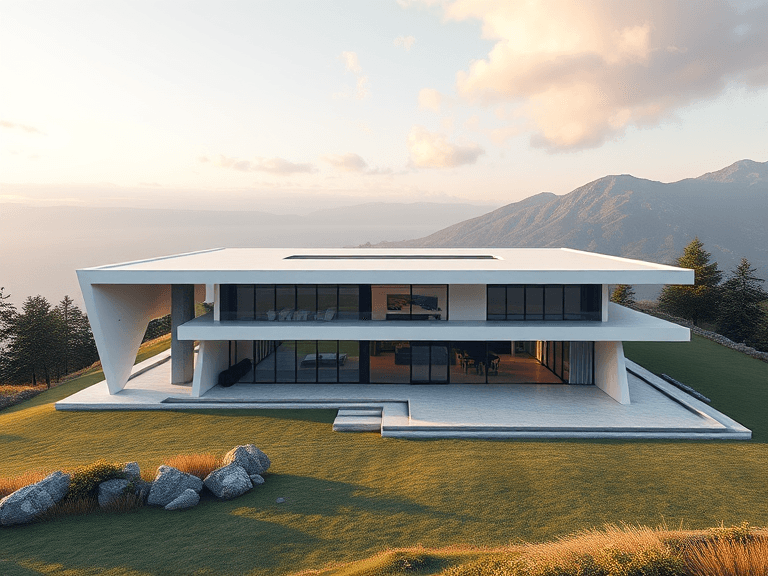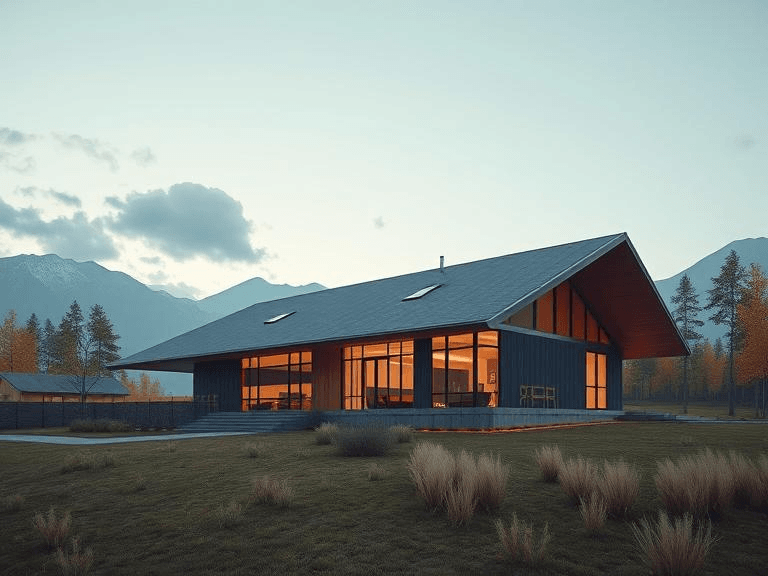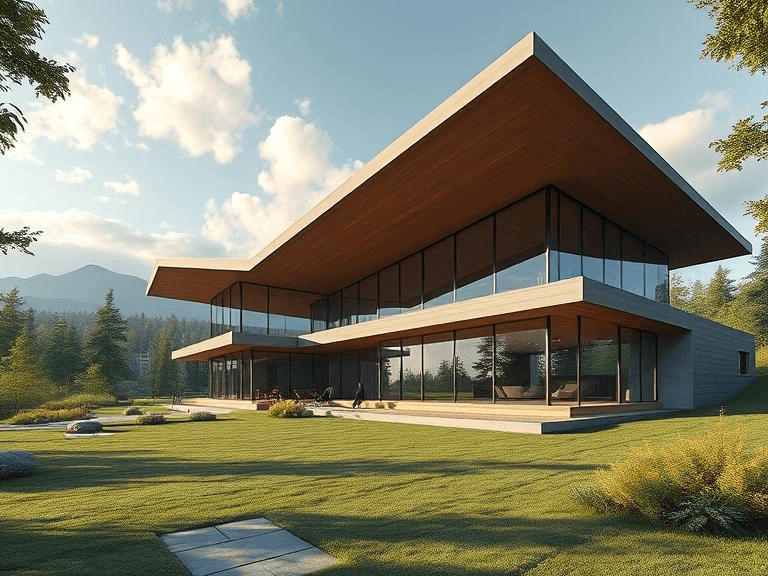
Flat roofs are a distinctive architectural feature that have gained traction in both residential and commercial building designs. Unlike traditional pitched roofs, which have a noticeable slope to facilitate runoff, flat roofs maintain a nearly level surface. This unique design offers a variety of aesthetic and functional benefits that appeal to architects, builders, and property owners alike. Generally, flat roofs are constructed with materials like modified bitumen, EPDM, or TPO, tailored to ensure durability and weather resistance.
Commonly used in urban settings, flat roofs maximize usable space and can be utilized for various purposes. For instance, they can be transformed into rooftop gardens, recreational areas, or even as additional storage space. In commercial buildings, flat roofing systems are often preferred for their cost-effectiveness and efficiency, especially when considering maintenance and installation costs. Moreover, the flat surface facilitates easier access for repair and cleaning, a significant advantage in a commercial environment where ongoing maintenance is crucial for operational efficiency.
It is essential to acknowledge the differences between flat roofs and their pitched counterparts. While pitched roofs are often favored for their effective drainage capabilities, flat roofs can collect water if not properly designed or maintained. This aspect introduces certain challenges, such as the need for careful planning in design and drainage systems. Understanding these benefits and challenges of flat roofs is integral to evaluating their suitability for specific projects, creating a strong foundation for further discussion on their advantages and drawbacks. As we explore this topic, a balanced view of both aspects will provide readers with crucial insights into flat roofing systems.
Benefits of Flat Roofs: Cost-Effectiveness
The decision to utilize a flat roof in construction can provide numerous cost-effective benefits, particularly appealing to budget-conscious projects. One of the immediate advantages of flat roofs lies in their simpler construction techniques compared to traditional sloped roofs. The straightforward architectural design often requires less labor and fewer materials, leading to considerable initial cost savings. These savings can be particularly beneficial for large-scale commercial buildings, where the cumulative effect on budget can be significant.
Beyond initial expenses, the long-term financial advantages associated with flat roofs further highlight their cost-effectiveness. Flat roofs generally require less maintenance than their pitched counterparts. The design allows for easier access, making routine inspections and repairs more straightforward. As a result, building owners may find reduced maintenance costs over the roof’s lifespan, alleviating the financial burden associated with upkeep. Properly installed flat roofs can last for many years, making them a cost-efficient option in the long run.
Energy efficiency is another critical factor contributing to the financial benefits of flat roofs. In many cases, flat roof designs can be enhanced with energy-efficient materials or technologies, such as reflective coatings or green roofing systems. These enhancements can lead to lower energy consumption for heating and cooling, ultimately translating into reduced utility expenses. Given the rising costs of energy, the ability to manage and lower such expenses through effective roofing solutions can significantly impact overall financial planning.
In conclusion, the benefits and challenges of flat roofs, particularly regarding cost-effectiveness, position them as an attractive option for various construction projects. Their initial savings, combined with lowered long-term maintenance and enhanced energy efficiency, make flat roofs a compelling choice for those looking to optimize their building budgets.
Benefits of Flat Roofs: Space Optimization
Flat roofs are often lauded for their efficient use of space, particularly in urban settings where land is limited and valuable. This design offers a unique opportunity to maximize usable areas that traditional pitched roofs cannot. One notable advantage is the potential for creating roof gardens. These green spaces not only provide a venue for relaxation but also improve air quality and promote urban biodiversity. As cities continue to expand, incorporating green spaces has become a priority for many urban planners.
In addition to roof gardens, flat roofs can accommodate outdoor living areas. These spaces can be transformed into decks or patios, enhancing the property’s square footage and providing occupants with a private retreat amidst the bustling city landscape. This flexibility allows homeowners and renters to enjoy the outdoors without sacrificing precious ground-level space. Such outdoor enhancements can be instrumental in fostering community among neighbors, as well as creating a desirable living environment for potential tenants or buyers.
Moreover, flat roofs offer an excellent platform for the installation of solar panels, capitalizing on the sun’s energy to reduce utility costs and contribute to a more sustainable living approach. The ability to harness renewable energy directly from the roof allows homeowners to engage in energy-efficient practices while optimizing the seldom-used space above their heads. This adaptability makes flat roofs particularly appealing in areas where energy costs are high or where sustainable living is a key concern.
Overall, the benefits of flat roofs in terms of space optimization are significant. By offering opportunities for gardens, outdoor areas, and solar installations, flat roofs stand out as a pragmatic choice for maximizing utility and enhancing the livability of urban spaces.

Benefits of Flat Roofs: Accessibility and Maintenance
Flat roofs offer a range of advantages, particularly when it comes to accessibility and maintenance. One of the most significant benefits is the ease of access afforded by the flat design, allowing for straightforward inspections and repairs. Unlike sloped roofs, which can pose risks and complications due to their incline, flat roofs provide a stable and safe working surface. This accessibility not only facilitates routine checks but also simplifies the process of addressing any issues that may arise over time.
Regular maintenance is crucial for prolonging the lifespan of any roofing system, and flat roofs are no exception. With their minimal slope, flat roofs often collect debris, such as leaves and dirt, making periodic cleansing a necessary part of upkeep. Ensuring that drainage systems, such as gutters and downspouts, are free from obstructions is vital to prevent water pooling. This is where the accessibility of flat roofs shines, as it allows homeowners and maintenance professionals to conduct thorough inspections without the need for expensive scaffolding or ladders, which are often required for sloped roofs.
Moreover, the maintenance process can be more efficient due to the roof’s design. Repairs can be addressed more promptly, as technicians can easily navigate the surface and identify problems such as leaks or punctures. Ensuring timely maintenance can lead to significant cost savings over time, as minor issues can be resolved before they escalate into more extensive and costly repairs.
In conclusion, the benefits and challenges of flat roofs must be carefully weighed by property owners. The ease of accessibility makes routine maintenance more manageable, which can lead to a longer lifespan for the roof and reduced long-term costs. Regular attention to flat roofs can ultimately enhance their performance and reliability, ensuring that they serve their intended purpose effectively.
Challenges of Flat Roofs: Drainage Issues
One of the primary challenges associated with flat roofs is the management of water drainage. Unlike sloped roofs, which facilitate the natural flow of rainwater, flat roofs can often create conditions for water to collect if they are not adequately designed or maintained. This accumulation of water, commonly referred to as ponding, can pose significant risks to the integrity of the roof and the overall structure of the building.
Proper drainage systems are critical in mitigating the issues that arise from flat roofs. Without effective drainage solutions, rainwater can become trapped in low areas, leading to prolonged exposure of roofing materials to moisture. Over time, this can result in leaks, which not only compromise the waterproofing of the roof but can also lead to structural damage, mold growth, and increased repair costs. Additionally, the weight of accumulated water can strain the roof structure, possibly leading to sagging or even catastrophic failure in extreme cases.
Furthermore, flat roofs require regular maintenance to ensure that drains, scuppers, and gutters are functioning optimally. Debris such as leaves and dirt can easily clog these drainage systems, exacerbating the risk of water pooling. This necessity for ongoing maintenance and vigilance adds a layer of complexity to the ownership of flat roofs that may not be as prevalent with pitched roofing systems.
In conclusion, while flat roofs present several advantages regarding design and space utilization, the challenges associated with drainage are significant. Homeowners and building managers must understand the critical importance of proper design, installation, and maintenance of drainage systems to prevent water buildup and ensure longevity and safety for their flat roofing systems.
Challenges of Flat Roofs: Weather Vulnerability
Flat roofs, despite their many advantages, present certain challenges, particularly regarding their vulnerability to extreme weather conditions. The unique design of flat roofs means they have less natural drainage compared to pitched roofs, which can lead to water accumulation. In cases of heavy rainfall, this accumulation can pose a significant risk, causing leaks and potentially damaging both the roofing structure and the interior spaces of the building.
Furthermore, flat roofs face heightened challenges in areas prone to severe wind. High winds can lift the roofing membrane, resulting in damage or detachment. This risk necessitates careful material selection and adherence to local building codes that dictate appropriate fastening methods to withstand wind uplift. Proper installation is critical, as even minor oversights can compromise the roof’s integrity during storms.
Another challenge associated with flat roofs is the risk of snow accumulation, especially in regions experiencing cold winters. The flat surface may allow snow to pile up, leading to a higher load that the roof must bear. If this weight exceeds the structural capacity of the roof, it can lead to sagging or, in extreme cases, catastrophic failure. To mitigate these risks, it’s essential to regularly remove snow and to design flat roofs with adequate load-bearing capacity in mind.
Temperature fluctuations also pose challenges for flat roofs. Extreme heat can cause certain materials to expand and contract, potentially leading to warping or cracking over time. Similarly, during cold spells, materials may become brittle and more susceptible to damage. To navigate these thermal changes, builders must choose appropriate materials that offer flexibility and durability, ensuring longevity and resilience in varying weather conditions.
In conclusion, while flat roofs offer unique benefits, their vulnerability to extreme weather conditions underscores the importance of careful design, material selection, and maintenance. Addressing these challenges can lead to a more durable and efficient roofing solution.
Challenges of Flat Roofs: Limited Lifespan
Flat roofs are often favored for their modern aesthetic and practicality, yet one of the primary challenges associated with them is their limited lifespan compared to traditional pitched roofs. Typically, flat roofing systems can last anywhere from 10 to 30 years, depending greatly on the materials used and the environmental elements to which they are exposed. Common materials for flat roofs include EPDM, TPO, and PVC, each varying in durability and maintenance requirements.
The lifespan of flat roofs can be significantly affected by several factors. First and foremost, weather conditions play a crucial role. Areas with extreme temperatures, high levels of precipitation, or frequent exposure to UV rays can lead to accelerated wear and tear. For instance, intense sunlight can cause materials to crack or degrade over time, while pooling water may lead to leaks and structural damage. Effectively managing drainage is essential to combat these issues and enhance the longevity of flat roofing systems.
Furthermore, poor installation practices can contribute to the deterioration of flat roofs. Ensuring that the roof is installed by professionals using proper techniques and high-quality materials can mitigate future challenges. Regular maintenance is also a critical factor in extending the lifespan of flat roofs. This includes routine inspections, preventive repairs, and professional cleaning to eliminate debris and algae buildup that can trap moisture.
In conclusion, while flat roofs come with their set of benefits, understanding the challenges associated with their limited lifespan is essential for homeowners and builders alike. By being aware of the influencing elements and taking proactive measures, such as proper installation and maintenance, it is possible to enhance the durability and overall performance of flat roofing systems.
Best Practices for Flat Roof Installation
Installing a flat roof requires meticulous planning and execution to ensure durability and effectiveness. One of the first steps is the selection of appropriate materials. Flat roofs typically utilize various materials, including modified bitumen, EPDM rubber, and TPO. Each of these materials has unique properties, advantages, and potential drawbacks. For instance, EPDM is known for its longevity and resistance to weather conditions, while TPO offers superior energy efficiency. It is crucial to evaluate these options based on climatic considerations, budget constraints, and the specific needs of the building.
Proper waterproofing techniques are another essential aspect of achieving a successful flat roof installation. Due to the horizontal nature of flat roofs, they are more susceptible to water pooling, which can lead to leaks or structural damage. To counteract this issue, installing quality waterproof membranes is imperative. These membranes should be adequately overlapped and sealed to create a barrier against moisture. Additionally, integrating drainage systems, such as scuppers or internal drains, can help manage water flow effectively and avoid stagnant water accumulations.
Working with experienced contractors is equally important in the installation process. Professionals with concrete experience in flat roof applications possess valuable insights and expertise that can help avoid common pitfalls. They are familiar with local building codes and industry standards, ensuring compliance that can prevent future challenges. Furthermore, experienced contractors can guide the selection of materials suited to specific environmental conditions and installation techniques that enhance the roof’s longevity and performance. By focusing on these best practices, property owners can significantly mitigate the challenges associated with flat roofs and improve their overall experience with this roofing style.
Conclusion: Weighing the Pros and Cons
In evaluating the benefits and challenges of flat roofs, it is essential to approach the topic with a clear understanding of both their advantages and potential drawbacks. Flat roofs are particularly valued for their modern aesthetic and the ability to maximize usable space, providing opportunities for rooftop gardens and additional living areas. Additionally, the construction process is typically more cost-effective due to the straightforward installation, which can lead to lower labor costs and quicker project completion.
However, several challenges must also be taken into account. One of the primary concerns associated with flat roofs is water drainage; improper drainage systems can lead to pooling water. This, in turn, may contribute to damage over time, ranging from leaks to structural integrity issues. Furthermore, the flat roof designs tend to have a shorter lifespan than traditional pitched roofs, necessitating more frequent maintenance and repairs. Climate is another critical factor, as areas with heavy snowfall or rain can pose significant risks to flat roof performance.
Ultimately, individuals contemplating flat roofs must carefully consider their unique circumstances, including local weather conditions, building regulations, and financial resources. Engaging with roofing professionals can provide invaluable insights tailored to specific needs, helping to mitigate potential risks and enhance overall satisfaction with the roofing choice. Understanding the benefits and challenges of flat roofs enables homeowners to make informed decisions that align with their goals and preferences. Each roof type has its merits, yet the best choice ultimately lies in a thorough assessment of how well they meet personal criteria.


